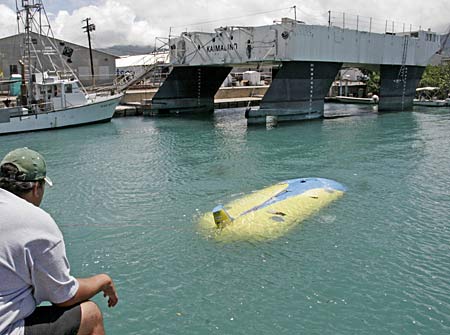
|
UH readies first
autonomous
undersea robot
Industry and naval officials are
optimistic despite a failed test
University of Hawaii mechanical engineers and students are close to completing the country's first autonomous robotic vehicle for deep-ocean work.
 A sensor failed to work, causing a glitch in the performance of the group's Semi-Autonomous Underwater Vehicle for Intervention during a demonstration Friday at the UH Marine Center at Snug Harbor, Sand Island.
A sensor failed to work, causing a glitch in the performance of the group's Semi-Autonomous Underwater Vehicle for Intervention during a demonstration Friday at the UH Marine Center at Snug Harbor, Sand Island.
But industry and Navy research officials were enthusiastic about the unique vehicle's potential.
"This is technology that the world needs," said Gary Godshalk, of Lockheed Martin, in Kailua. "Underwater vehicles are the future."
Researchers in the UH Mechanical Engineering Department's Autonomous Systems Laboratory have received about $12 million from the Office of Naval Research since 1997 for robotic vehicle development.
The battery-powered aluminum vehicle, about the size of a sport utility vehicle, is the same one shown to Navy and NASA officials two years ago, with a blue and yellow cover and significant technological advances.
Most important, it has computers and sensors to make a decision to perform a task and a 5-foot, 150-pound autonomous manipulator, or arm.
"Everything that goes inside it has changed," said Song Choi, assistant dean of the College of Engineering and director and chief executive officer of Marine Autonomous Systems Engineering.
The UH scientists formed the company to take over the engineering development after conducting the research in the Autonomous Systems Laboratory. Choi is on leave as the laboratory's associate director.
Choi said there is no underwater vehicle with the capabilities of the semiautonomous underwater vehicle. "We'd be the first ones to do it."
Rich Carlin, director of ONR's Division of Mechanics and Energy Conversion, said he is anxious to see the autonomous arm's capabilities. "The ability to do mechanical work underwater is extremely valuable," he said, noting the Navy's obvious interests in underwater mines, surveillance and retrieval.
Underwater vehicles are available to do imaging and surveying, but UH's vehicle would be the first to carry out work in the ocean autonomously, he said.
Choi said 99 percent of the vehicle's system is autonomous, with 1 percent semiautonomous for a communications link for safety. A signal could be sent to the vehicle to stop and return if necessary, he said.
It is designed to operate to a depth of about 4 miles, enabling recovery of wreckage or pipes, sea floor surveillance, or hooking and unhooking instruments on the ocean floor.
It will be able to go to a target automatically, and the arm will deploy to do a task with no humans involved, Choi said. "The ultimate goal is to leave it in the water, and it will come back when the batteries are down. Safety-wise, it can't get better."
Giacomo Marani, who works on the autonomous manipulator, said the new design consumes less power, and the autonomous arm could operate for seven to eight hours. "We're waiting for a fuel cell to do more than one day," he said.
The vehicle was supposed to pick up a tool from the bay and deploy it over a target Friday. Observers could see the arm moving and tracking its target on TV monitors in a small building at the water's edge.
But Choi said there was a communication problem. A sensor that worked fine during tests Wednesday was not reading properly Friday, he said.
He said the vehicle is about 90 percent completed and within the next year or two should have all the tasks, functions and features the scientists want.
It has about 20 to 25 sensors for navigation, mapping and other purposes, Choi said. High-resolution cameras and sonar will prevent collisions with other objects.
Choi said a vehicle about half the size of the semiautonomous underwater vehicle would be easier to launch and commercialize. He said the Department of Defense, treasure hunters and even the entertainment industry are interested in a smaller version.
Carlin said the Navy is interested in long-range vehicles that can stay underwater longer, which requires more advanced batteries and fuel cell technology.
"A lot of work still is needed, but there is tremendous potential. The UH has a fantastic program," he added.
Edward H.W. Young, project manager of the Hawaii Technology Development Venture, an Office of Naval Research project, said the development is great from the standpoint of industry growth in Hawaii.
With a cloud over Pearl Harbor's future, he said, "We have to find other infrastructure capabilities."
Development of robotic vehicles with fuel and sensor technology could start an industry and "provide an avenue for kids to get involved in science," he said.
E-mail to City Desk
[News] [Business] [Features] [Sports] [Editorial] [Do It Electric!]
[Classified Ads] [Search] [Subscribe] [Info] [Letter to Editor]
[Feedback]
